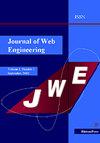基于网络的新冠肺炎疑似感染分类模型的非接触边缘计算解决方案
IF 0.7
4区 计算机科学
Q4 COMPUTER SCIENCE, SOFTWARE ENGINEERING
引用次数: 0
摘要
最近爆发的新冠肺炎冠状病毒大流行需要开发基于网络的非接触式边缘分析解决方案。非接触式传感器通过网络工程技术充当网络服务器和边缘分析之间的接口。对能够根据早期症状识别新冠肺炎患者的边缘设备分类模型的需求已经变得明显。特别地,需要这种分类模型的非接触式实现来有效地防止病毒感染并最小化交叉感染。在这项工作中,我们研究了各种非接触式生物传感器(如远程光电体积描记术、雷达和红外传感器)的使用,以减少与患者的有效身体接触,并测量他们的生物特征数据和生命体征。我们进一步解释了根据测量的生命体征和症状对疑似新冠肺炎感染进行分类的方法。这项研究的结果可以通过基于移动的边缘计算应用程序应用于患者分类。在模型中分析了咳嗽、喉咙痛、发烧、头痛、肌痛和关节痛等症状之间的相关性。我们实现了一个使用生命体征进行性能评估的机器学习分类模型,并提出了一个通过微调高性能分类模型来实现的集成模型。所提出的集合模型成功地区分了疑似患者,准确率、曲线下面积和F1得分分别为94.4%、98.4%和94.4%。本文章由计算机程序翻译,如有差异,请以英文原文为准。
Web-based Non-contact Edge Computing Solution for Suspected COVID-19 Infection Classification Model
The recent outbreak of the COVID-19 coronavirus pandemic has necessitated the development of web-based, non-contact edge analytics solutions. Non-contact sensors serve as the interface between web servers and edge analytics through web engineering technology. The need for an edge device classification model that can identify COVID-19 patients based on early symptoms has become evident. In particular a non-contact implementation of such a classification model is required to efficiently prevent viral infection and minimize cross-infection. In this work, we investigate the use of diverse non-contact biosensors (e.g., remote photoplethysmography, radar, and infrared sensors) for reducing effective physical contact with patients and for measuring their biometric data and vital signs. We further explain a classification method for suspected COVID-19 infection based on the measured vital signs and symptoms. The results of this study can be applied in patient classification by mobile-based edge computing applications. The correlation between symptoms comprising cough, sore throat, fever, headache, myalgia, and arthralgia are analyzed in the model. We implement a machine learning classification model using vital signs for performance evaluation, and propose an ensemble model realized by fine-tuning the high-performing classification models. The proposed ensemble model successfully distinguishes suspected patients with an accuracy, area under curve, and F1 scores of 94.4%, 98.4%, and 94.4%, respectively.
求助全文
通过发布文献求助,成功后即可免费获取论文全文。
去求助
来源期刊

Journal of Web Engineering
工程技术-计算机:理论方法
CiteScore
1.80
自引率
12.50%
发文量
62
审稿时长
9 months
期刊介绍:
The World Wide Web and its associated technologies have become a major implementation and delivery platform for a large variety of applications, ranging from simple institutional information Web sites to sophisticated supply-chain management systems, financial applications, e-government, distance learning, and entertainment, among others. Such applications, in addition to their intrinsic functionality, also exhibit the more complex behavior of distributed applications.
 求助内容:
求助内容: 应助结果提醒方式:
应助结果提醒方式:


